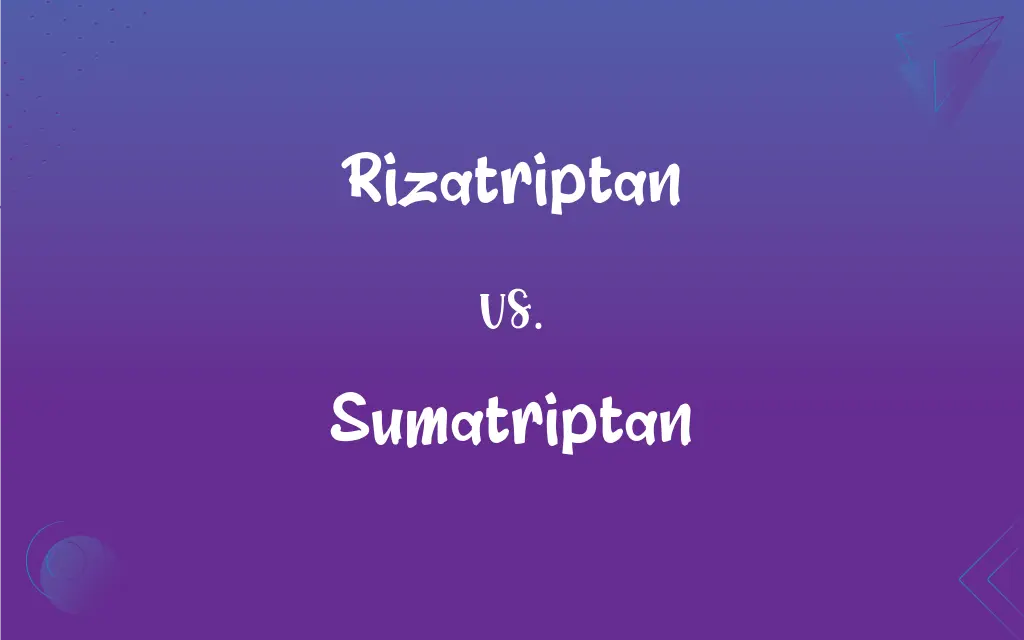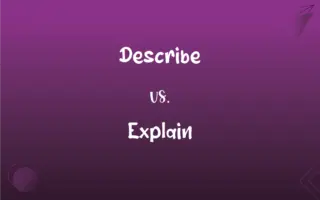Rizatriptan vs. Sumatriptan: What's the Difference?
Edited by Aimie Carlson || By Harlon Moss || Updated on October 17, 2023
Rizatriptan and sumatriptan are both medications used to treat migraine attacks, but they differ in their chemical structure, onset of action, and side effects.

Key Differences
Rizatriptan and sumatriptan are both triptans, a class of medications specifically used to treat migraines. Rizatriptan, known under the brand name Maxalt, is praised for its quick onset of action, often relieving pain within 2 hours of ingestion. Sumatriptan, marketed as Imitrex among others, was the first triptan developed and has been a crucial medication in migraine management since the early 1990s. Both are selective serotonin receptor agonists, meaning they target serotonin receptors in the brain to alleviate migraine symptoms.
When it comes to administration, rizatriptan is available in tablets and orally disintegrating tablets, making it versatile and convenient for different patient preferences. Sumatriptan offers more varied forms, including tablets, nasal spray, and subcutaneous injections. The diversity in sumatriptan's administration methods allows for flexibility in addressing varying degrees of migraine severity and patient comfort levels.
The side effect profiles of rizatriptan and sumatriptan also warrant consideration. Common side effects for rizatriptan include dizziness, fatigue, and tightness in the chest or throat. Sumatriptan shares many of these side effects but is more frequently associated with sensations of tingling or warmth. Both medications can raise blood pressure and are contraindicated in patients with certain cardiovascular conditions.
Speaking of efficacy, both rizatriptan and sumatriptan are effective for migraine relief, but individual responses can vary. Rizatriptan is often highlighted for its rapid relief, usually effective within 2 hours. Sumatriptan's effectiveness can depend on the form; for example, the injection can provide relief within 10-15 minutes, much faster than its oral form.
Lastly, cost and accessibility are significant factors in choosing between rizatriptan and sumatriptan. Sumatriptan, being older, is typically more affordable and widely available as a generic. Rizatriptan is also available generically, but might sometimes be more expensive than sumatriptan. The choice often depends on individual health insurance coverage and specific patient medical history.
ADVERTISEMENT
Comparison Chart
Word Origin
Derived from "triptan," signifying its class; "riza" offers no specific linguistic meaning.
"Suma-" lacks clear meaning, while "-triptan" denotes its drug class.
Syllables
Five: ri-za-trip-tan
Four: su-ma-trip-tan
Letter Count
11
10
First Letter
R
S
Position in Alphabet
R is the 18th letter, earlier in the alphabet.
S is the 19th letter, following R.
ADVERTISEMENT
Rizatriptan and Sumatriptan Definitions
Rizatriptan
Rizatriptan belongs to the triptan drug class, working by narrowing blood vessels around the brain.
Rizatriptan effectively eased his symptoms by restricting blood flow in the cranial vessels.
Sumatriptan
Sumatriptan's availability in various forms—pills, nasal spray, and injection—accommodates diverse patient needs.
Her nausea during migraines made the sumatriptan nasal spray a preferable option.
Rizatriptan
Rizatriptan is a medication prescribed for the treatment of acute migraine attacks.
The doctor recommended rizatriptan to manage her sudden migraine episodes.
Sumatriptan
Sumatriptan, a member of the triptan class, functions by constricting blood vessels in the brain.
The vascular constriction induced by sumatriptan alleviated his throbbing headache.
Rizatriptan
Rizatriptan may induce side effects like dizziness, fatigue, or throat tightness in some patients.
Although rizatriptan relieved her migraines, she experienced noticeable drowsiness post-dosage.
Sumatriptan
Sumatriptan's common side effects include sensations of warmth or tingling and dizziness.
After taking sumatriptan, she often felt a slight warmth spreading across her forehead.
Rizatriptan
Rizatriptan can be administered orally, appealing to individuals who prefer not to use injections or nasal sprays.
Due to his aversion to needles, rizatriptan's oral tablets presented an ideal solution.
Sumatriptan
Sumatriptan is a medication used for treating migraines and cluster headaches.
Sumatriptan was her first line of defense against recurrent migraine attacks.
Rizatriptan
Rizatriptan is recognized for its rapid onset, often providing relief within 2 hours of consumption.
Her migraines, once debilitating, were quickly subdued with the prompt effectiveness of rizatriptan.
Sumatriptan
Sumatriptan provides rapid relief, especially the injectable form, effective within 10-15 minutes.
Faced with sudden, severe migraines, he found solace in sumatriptan's quick-acting injection.
Rizatriptan
An oral drug of the triptan class, C15H19N5, used in its benzoate form to treat migraine headaches.
Sumatriptan
A triptan drug, C14H21N3O2S, used also in the form of its succinate to treat migraine headache and cluster headache.
Rizatriptan
(medicine) A triptan agonist used in the treatment of migraine
Sumatriptan
A drug used for the treatment of migraine headaches.
FAQs
What are rizatriptan and sumatriptan?
Both rizatriptan and sumatriptan are medications used primarily for treating acute migraine headaches.
Can rizatriptan and sumatriptan be taken daily?
Both rizatriptan and sumatriptan are intended for acute migraine attacks, not daily preventative use.
What are the common side effects of rizatriptan and sumatriptan?
Rizatriptan can cause dizziness and fatigue, while sumatriptan may cause tingling, warmth, or dizziness.
How do rizatriptan and sumatriptan work?
Rizatriptan and sumatriptan work by constricting blood vessels in the brain and blocking certain pain pathways.
Are there people who shouldn't take rizatriptan or sumatriptan?
Individuals with certain cardiovascular conditions should avoid both rizatriptan and sumatriptan.
Are rizatriptan and sumatriptan available in multiple forms?
Rizatriptan is generally available in tablet form, while sumatriptan comes in tablets, nasal sprays, and injections.
Can I use rizatriptan or sumatriptan for tension headaches?
Rizatriptan and sumatriptan are specifically designed for migraines, not tension headaches.
Are rizatriptan and sumatriptan over-the-counter drugs?
Both rizatriptan and sumatriptan require a prescription in the United States.
Can I take rizatriptan or sumatriptan during pregnancy?
The safety of rizatriptan and sumatriptan during pregnancy is uncertain; consult your healthcare provider.
Can I drink alcohol while taking rizatriptan or sumatriptan?
Alcohol may exacerbate the side effects of both rizatriptan and sumatriptan; it's best to avoid it.
How fast do rizatriptan and sumatriptan work?
Rizatriptan typically works within 2 hours; sumatriptan's effect time varies by form, with injections being the fastest.
Do rizatriptan and sumatriptan have generic versions?
Yes, both medications are available in generic form.
Can I take rizatriptan and sumatriptan together?
Combining rizatriptan and sumatriptan is not recommended due to increased risk of side effects.
Will rizatriptan or sumatriptan affect my birth control?
There's no evidence that rizatriptan or sumatriptan interferes with hormonal birth control.
Is it safe to drive after taking rizatriptan or sumatriptan?
Dizziness is a side effect of both rizatriptan and sumatriptan, so driving may be unsafe after taking them.
Do rizatriptan and sumatriptan interact with other drugs?
Yes, both can interact with certain antidepressants and other medications; provide your doctor with a full medical history before use.
What should I do if I miss a dose of rizatriptan or sumatriptan?
Both rizatriptan and sumatriptan are taken as needed for migraines, so there's no issue with "missing" a dose.
Are rizatriptan and sumatriptan addictive?
Neither rizatriptan nor sumatriptan is known to be addictive, but they should be used as directed by a physician.
Can rizatriptan or sumatriptan cause weight gain?
Weight gain is not a commonly reported side effect of either rizatriptan or sumatriptan.
How are rizatriptan and sumatriptan metabolized in the body?
Both rizatriptan and sumatriptan are primarily metabolized by the liver.
About Author
Written by
Harlon MossHarlon is a seasoned quality moderator and accomplished content writer for Difference Wiki. An alumnus of the prestigious University of California, he earned his degree in Computer Science. Leveraging his academic background, Harlon brings a meticulous and informed perspective to his work, ensuring content accuracy and excellence.
Edited by
Aimie CarlsonAimie Carlson, holding a master's degree in English literature, is a fervent English language enthusiast. She lends her writing talents to Difference Wiki, a prominent website that specializes in comparisons, offering readers insightful analyses that both captivate and inform.































































